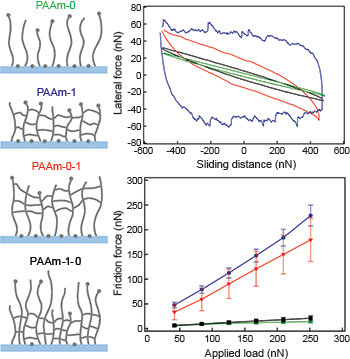AFM Systems
AFM Accessories
Learning
Contact Us

Friction and other dissipative processes play a crucial role in applications ranging from car engines to hip replacements, but key aspects of these phenomena are still not well understood. In addition, tribological behavior can change dramatically as critical dimensions shrink, due to increased surface-to-volume ratios. Atomic force microscopes provide many capabilities for tribological experiments on atomic to micrometer length scales. Current models can measure very small lateral forces over a wide range of normal forces, with higher force sensitivity and lower noise. Increased scan speeds enable velocity-dependent studies over a wider range. These and other features such as higher spatial resolution, extensive environmental control, and numerous routines for setup and data analysis make atomic force microscopy a powerful tool for nanotribology.
Ask an AFM expert for more information"An ultra-low frictional interface combining FDTS SAMs with molybdenum disulfide," X. A. Cao, X. Gan, Y. Peng, Y. Wang, X. Zeng, H. Lang, J. Deng, and K. Zou, Nanoscale 10, 378 (2018). https://doi.org/10.1039/c7nr06471c
"Improvement of load bearing capacity of nanoscale superlow friction by synthesized fluorinated surfactant micelles," J. Li, Z. P. Dou, Y. Liu, J. Luo, and J. X. Xiao, ACS Appl. Nano Mater. 1, 953 (2018). https://doi.org/10.1021/acsanm.7b00367
"Robust microscale superlubricity under high contact pressure enabled by graphene-coated microsphere," S. W. Liu, H. P. Wang, Q. Xu, T. B. Ma, G. Yu, C. Zhang, D. Geng, Z. Yu, S. Zhang, W. Wang, Y. Z. Hu, H. Wang, and J. Luo, Nat. Commun. 8, 14029 (2017). https://doi.org/10.1038/ncomms14029
"Nanomechanics of pH-responsive, drug-loaded, bilayered polymer grafts,” P. C. Nalam, H.-S. Lee, N. Bhatt, R. W. Carpick, D. M. Eckmann, and R. J. Composto, ACS Appl. Mater. Interfaces 9, 12936 (2017). https://doi.org/10.1021/acsami.6b14116
"A novel approach to decrease friction of graphene," X. Zeng, Y. Peng, and H. Lang, Carbon 118, 233 (2017). https://doi.org/10.1016/j.carbon.2017.03.042
"Static and kinetic friction characteristics of nanowire on different substrates," H.-J. Kim, G. H. Nguyen, D. L. C. Ky, D. K. Tran, K.-J. Jeon, and K.-H. Chung, Appl. Surf. Sci. 379, 452 (2016). https://doi.org/10.1016/j.apsusc.2016.04.097
"Effect of structure on the tribology of ultrathin graphene and graphene oxide films," H. Chen and T. Filleter, Nanotechnology 26, 135702 (2015). https://doi.org/10.1088/0957-4484/26/13/135702
"Interaction between selected MoS2 nanoparticles and ZDDP tribofilms," A. Tomala, B. Vengudusamy, M. Rodríguez Ripoll, A. N. Suarez, M. Remškar, and R. Rosentsveig, Tribol. Lett. 59, 26 (2015). https://doi.org/10.1007/s11249-015-0552-z
"Ionic liquids confined in hydrophilic nanocontacts: Structure and lubricity in the presence of water," R. M. Espinosa-Marzal, A. Arcifa, A. Rossi, and N. D. Spencer, J. Phys. Chem. C 118, 6491 (2014). https://doi.org/10.1021/jp5000123
"Friction force microscopy: a simple technique for identifying graphene on rough substrates and mapping the orientation of graphene grains on copper,” A. J. Marsden, M. Phillips, and N. R. Wilson, Nanotechnology 24, 255704 (2013). https://doi.org/10.1088/0957-4484/24/25/255704
"Covalently attached organic monolayers onto silicon carbide from 1-alkynes: molecular structure and tribological properties," S. P. Pujari, L. Scheres, T. Weidner, J. E. Baio, M. A. Cohen Stuart, C. J. van Rijn, and H. Zuilhof, Langmuir 29, 4019 (2013). https://doi.org/10.1021/la400040e
"In situ quantitative study of nanoscale triboelectrification and patterning," Y. S. Zhou, Y. Liu, G. Zhu, Z. H. Lin, C. Pan, Q. Jing, and Z. L. Wang, Nano Lett. 13, 2771 (2013). https://doi.org/10.1021/nl401006x
"Lubrication with oil-compatible polymer brushes," R. M. Bielecki, E. M. Benetti, D. Kumar, and N. D. Spencer, Tribol. Lett. 45, 477 (2012). https://doi.org/10.1007/s11249-011-9903-6
"Atomic force microscope investigation of the boundary-lubricant layer in articular cartilage," S. M. T. Chan, C. P. Neu, G. Duraine, K. Komvopoulos, and A. H. Reddi, Osteoarthr. Cartilage 18, 956 (2010). https://doi.org/10.1016/j.joca.2010.03.012
"Local nanoscale heating modulates single-asperity friction," C. Greiner, J. R. Felts, Z. Dai, W. P. King, and R. W. Carpick, Nano Lett. 10, 4640 (2010). https://doi.org/10.1021/nl102809k
"Friction force microscopy of lubricin and hyaluronic acid between hydrophobic and hydrophilic surfaces," D. P. Chang, N. I. Abu-Lail, J. M. Coles, F. Guilak, G. D. Jay, and S. Zauscher, Soft Matter 5, 3438 (2009). https://doi.org/10.1039/b907155e
"In situ friction measurement on murine cartilage by atomic force microscopy," J. M. Coles, J. J. Blum, G. D. Jay, E. M. Darling, F. Guilak, and S. Zauscher, J. Biomech. 41, 541 (2008). https://doi.org/10.1016/j.jbiomech.2007.10.013
"Diamond and hard carbon films for microelectromechanical systems (MEMS)—a nanotribological study," I. S. Forbes and J. I. Wilson, Thin Solid Films 420, 508 (2002). https://doi.org/10.1016/S0040-6090(02)00854-4